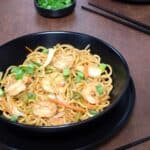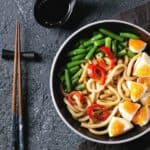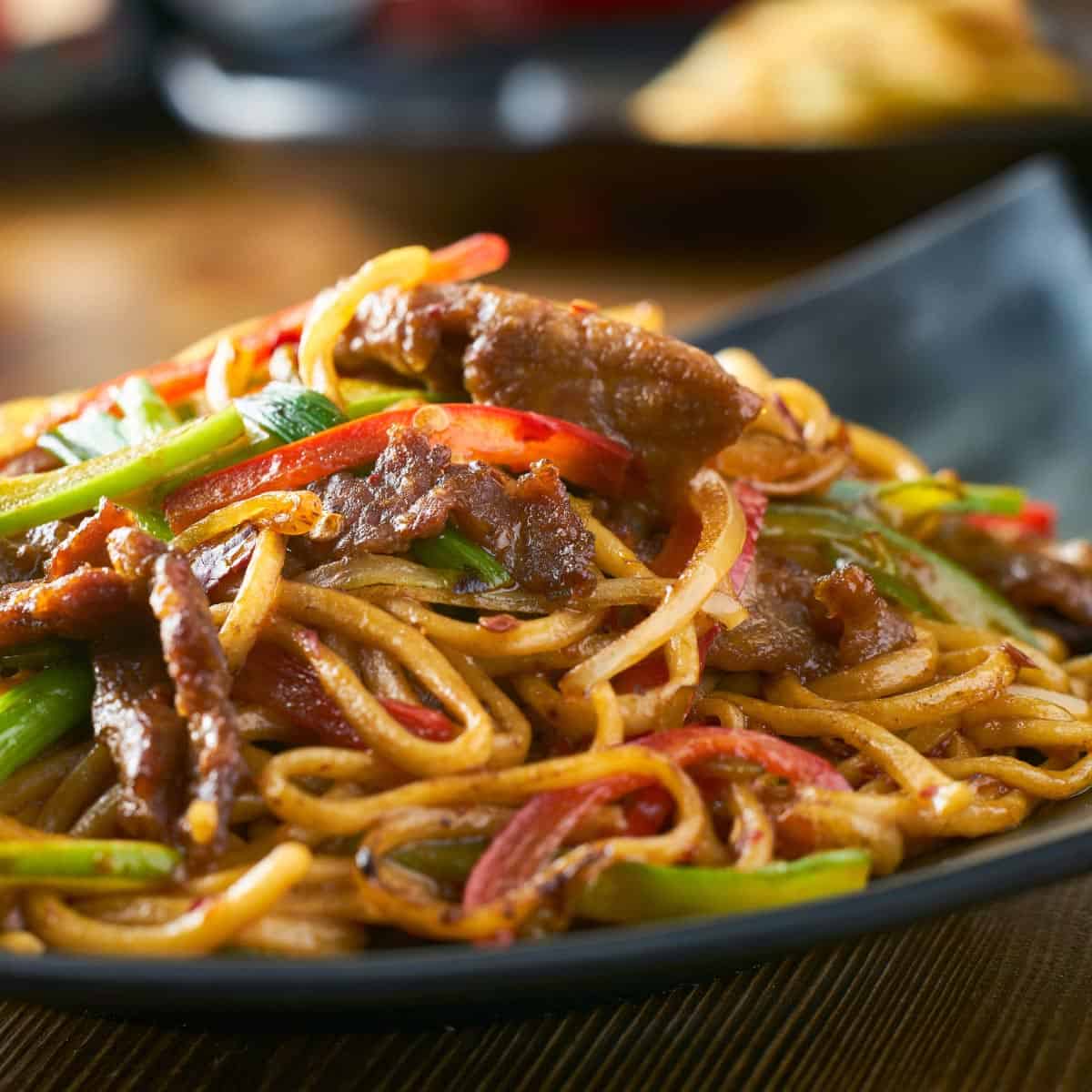Ah, Lo Mein! That wonderful staple of many Asian cuisines has found a beloved place in the hearts (and stomachs) of so many. Whether chicken lo mein, shrimp lo mein, or the delightful veggie lo mein, it's a dish that truly sings with a symphony of flavors. But what do you do with leftover lo mein? How do you reheat it to capture that just-cooked magic? 🍜
Jump to:
Understanding Lo Mein
Before going over the reheating methods, let's talk about what makes lo mein so special.
Originating from Chinese restaurants, lo mein is a stir-fry dish made with egg noodles, often combined with a variety of proteins like chicken, beef, or shrimp, and vegetables such as bok choy, snow peas, and bean sprouts.
The noodles are coated in a delicious lo mein sauce made of soy sauce, oyster sauce, hoisin sauce, sesame oil, and sometimes a splash of chicken broth for extra depth of flavor.

Reheating Methods: Pros, Cons, and Step-by-Step Guides
Stovetop Method
The stovetop method, particularly using a frying pan or large skillet, is undoubtedly the best way to reheat lo mein. It's not just reheating; it's almost like giving your noodles a second round of stir-frying. This method works wonders in retaining the depth of flavor and keeping the noodles al dente.
Step-by-Step Process
- Heat the Pan: Place a non-stick pan or wok over medium heat. Add a tablespoon of oil – olive oil or a little sesame oil for an authentic Asian touch.
- Add Lo Mein: Add your leftover lo mein noodles. If it's chicken lo mein or beef lo mein, ensure the pieces are spread out.
- Rehydrate: If the noodles seem dry, add a splash of water, chicken broth, or a splash of soy sauce. This brings back moisture and a bit of zing.
- Stir-fry: Stir continuously. Add fresh ingredients, such as green onions or bean sprouts, for added crunch.
- Serve Hot: After 3-4 minutes, once the lo mein is heated and sizzling, it's ready to be enjoyed.
Pros
- Flavor Enhancement: The stovetop method, especially when using a wok or large skillet, allows adding extra ingredients like green onions or a splash of soy sauce, enhancing the depth of flavor.
- Texture Control: You can achieve a desirable texture, keeping the noodles al dente and vegetables crisp.
- Even Heating: Stirring the lo mein continuously ensures even heating and prevents clumping or sticking.
Cons
- Requires Attention: This method demands constant stirring and monitoring.
- Risk of Overcooking: There's a possibility of overcooking the noodles or vegetables, especially if left unattended.
- Inconsistent Heating: Without proper technique, you might end up with unevenly heated lo mein.
Microwave Method
The microwave is a great option when you're short on time and need a quick meal. It's not just about zapping the noodles; it's about reviving them in a microwave-safe dish with care to avoid a mushy outcome.
Step-by-Step Process
- Prepare the Noodles: Place the leftover lo mein noodles in a microwave-safe dish. Spread them out evenly for consistent heating.
- Add Moisture: Cover with a damp paper towel or a microwave-safe lid. This helps in retaining moisture.
- Microwave: Heat on high for about 2-3 minutes. Pause halfway through the cooking time to stir the noodles, ensuring even heating.
- Check and Serve: Check if they're heated through. If not, continue microwaving in 30-second increments.
Pros
- Quick and Convenient: Ideal for a fast and easy reheating option, especially when time is of the essence.
- Less Cleanup: Usually involves just one microwave-safe dish, making for an easy cleanup.
Cons
- Uneven Heating: Microwave heating can be uneven, leaving some parts too hot and others still cold.
- Texture Loss: Noodles can become mushy or rubbery if overheated.
- Moisture Loss: Without a damp paper towel or microwave-safe lid, the lo mein can dry out quickly.
Oven Method
Reheating lo mein in an oven, especially using an oven-safe dish, is a great way to handle larger quantities. This method gently warms the noodles, allowing the flavors to meld beautifully.
Step-by-Step Process
- Preheat the Oven: Set your oven to 350°F (175°C).
- Prepare the Dish: Place the lo mein in an oven-safe dish. To prevent drying, add a bit of water or soy sauce.
- Cover: Loosely cover the dish with aluminum foil. This helps trap the steam and keeps the noodles moist.
- Bake: Put it in the oven for about 10-15 minutes. Check halfway to stir and ensure even heating.
- Serve Warm: Once done, serve your deliciously reheated lo mein.
Pros
- Suitable for Large Batches: Ideal for reheating large quantities of lo mein at once.
- Gentle Heating: The oven provides a more gentle heat, reducing the risk of overcooking the noodles.
Cons
- Time-Consuming: It takes longer than other methods, which is not ideal for a quick meal.
- Risk of Drying Out: Noodles can dry out if not appropriately covered with aluminum foil or left in the oven for too long.
Air Fryer Method
Reheating lo mein in an air fryer is a relatively new but increasingly popular method. It's a great way to add a crispy texture to the noodles, transforming your leftover Chinese food into a quick meal with a gourmet twist. Whether chicken lo mein, beef lo mein, or even a veggie lo mein, using an air fryer can add an exciting dimension to your dish.
Step-by-Step Process
- Preheat the Air Fryer: Set your air fryer to 350°F (about 175°C). This is the ideal cooking time temperature for achieving that golden brown perfection.
- Prepare the Lo Mein: Place the leftover lo mein in the air fryer basket. Try to spread it out evenly for consistent cooking. If it’s a shrimp lo mein recipe or has larger chicken pieces, make sure they are well distributed.
- Add a Light Splash: To prevent drying, add a tiny splash of water or soy sauce. This helps to rehydrate the noodles and keep them moist.
- Air Fry: Cook for about 3-4 minutes. Halfway through, give the basket a gentle shake or use tongs to stir the lo mein. This ensures even heating and crispiness.
- Serve and Enjoy: Once the lo mein is heated through and has reached your desired level of crispiness.
Pros
- Crispy Texture: Adds a unique crispy edge to the noodles, providing a different eating experience.
- Quick Heating: Generally faster than the oven, making it a convenient option.
Cons
- Size Limitations: Not suitable for large quantities due to the size constraints of most air fryers.
- Risk of Overcooking: Can easily overcook or dry out the lo mein if not monitored closely.
Common Mistakes to Avoid When Reheating Lo Mein
- Overheating: Overheating on the stovetop or in the microwave is a common error. It can turn your lo mein, particularly if it's made with delicate egg noodles or spaghetti noodles, into a mushy, unappetizing mess.
- Solution: Heat on medium on the stovetop and stir constantly. In the microwave, heat in short intervals and check regularly.
- Uneven Heating: Microwaves can heat food unevenly, leaving you with parts of your lo mein still cold.
- Solution: Stir halfway through microwaving and consider using a microwave-safe dish that promotes even heating.
- Drying Out the Noodles: The oven and air fryer can dry the noodles, especially if they're not covered properly or left too long.
- Solution: Cover the dish with aluminum foil in the oven. A quick spritz of water or a splash of soy sauce can help in the air fryer.
- Using Too High Heat on the Stovetop: Cooking on high heat can quickly lead to dry, tough noodles and vegetables.
- Solution: To keep everything moist, cook on medium-high heat and add a bit of liquid, such as chicken broth or water.
- Not Adding Moisture When Needed: Lo mein can dry out after refrigeration. Reheating without adding any moisture can result in dry, unappetizing noodles.
- Solution: To reintroduce moisture, add water, chicken broth, or soy sauce.
- Crowding the Pan: Overcrowding the pan can steam the noodles instead of reheating them, creating a mushy texture.
- Solution: If you have a lot of lo mein, reheat it in batches in a large skillet or non-stick pan to ensure each noodle heats evenly.
- Not Accounting for Different Components: Lo mein often contains meat, vegetables, and sauces. Not considering these can lead to uneven reheating.
- Solution: Be mindful of the different components. For example, delicate vegetables like bok choy or snow peas might need less heat than denser components like cooked noodles.
- Reheating Multiple Times: Reheating lo mein multiple times can degrade its quality and raise food safety concerns.
- Solution: Only reheat the amount you plan to eat in one sitting.
Top Tip
By avoiding these common mistakes, you can ensure that your leftover lo mein retains its delightful flavors and textures, turning it into a delicious meal that rivals its first-time serving. The key to successful reheating lies in gentle heat, a bit of moisture, and careful attention.

How to Properly Store Leftover Lo Mein
Proper storage of lo mein is crucial for maintaining its freshness, flavor, and safety. Here's how to store lo mein effectively:
- Cooling and Preparing for Storage: Proper storage of lo mein begins with letting the dish cool to room temperature. This step is vital to avoid condensation within the storage container, which could otherwise make the noodles lose their appealing texture. However, it's essential to balance this with food safety considerations; lo mein shouldn't be left out for more than two hours to prevent bacterial growth.
- Selecting the Right Storage Container: The choice of container is crucial in preserving the quality of lo mein. Airtight containers are the best option as they prevent the noodles from drying out and keep out any odors from the fridge, ensuring that your lo mein retains its original flavor. If dealing with larger quantities, it's wise to portion the lo mein into smaller containers. This practice is not only convenient for reheating but also helps maintain the freshness of each serving.
- Refrigeration and Freezing: Once in an airtight container, lo mein can be stored in the refrigerator. Generally, it stays fresh and retains its taste for about 3-4 days. If you need to store lo mein for a longer period, freezing is a viable solution. Using freezer bags or freezer-safe containers, expel as much air as possible to prevent freezer burn. Labeling these containers with the storage date is also a good practice to keep track of the lo mein's longevity. Properly frozen, lo mein can be stored for up to three months.
- Thawing the Frozen Lo Mein: It's essential to thaw your frozen lo mein properly. The ideal way to do this is by transferring it from the freezer to the refrigerator, allowing it to thaw overnight. This slow thawing process helps maintain the texture of the noodles and the integrity of the other ingredients. It's important to avoid thawing lo mein at room temperature, as this can lead to bacterial growth.
FAQ
It's not recommended to reheat lo mein multiple times as it can degrade the quality and raise food safety concerns. Reheat only the amount you'll consume.
Reheat it on the stove over medium heat and avoid overcooking. Stir constantly and add a bit of oil or water as needed.
Thaw it in the fridge overnight and then reheat it on the stove or in the microwave. Avoid thawing at room temperature.
Yes, you can add fresh ingredients like green onions, bean sprouts, or a splash of soy sauce for added flavor.
It should be evenly heated throughout and steaming hot. Check the temperature in the center of the dish.
Yes, but be cautious, as shrimp can become rubbery if overheated. Heat in short intervals and check frequently.
Conclusion
Lo mein, with its delightful mix of egg noodles, savory sauces, and fresh ingredients, is a staple in the world of Chinese cuisine. Whether you're enjoying chicken lo mein, beef lo mein, or veggie lo mein, the key to a delicious meal lies in how you store and reheat your noodles. By following these best methods, you can enjoy your lo mein as if it were freshly made, bringing a touch of the vibrant flavors of Chinese restaurants right into your home. Happy cooking!
Related
Looking for other recipes like this? Try these:
Quick and Easy Recipes
Looking for quick and easy recipes? Try this for dinner tonight!



























Comments
No Comments